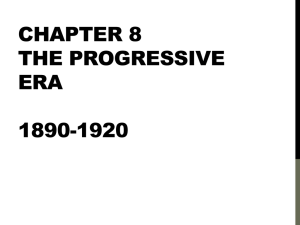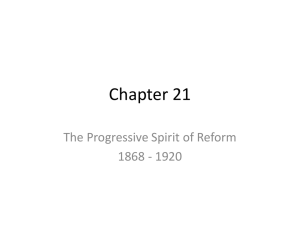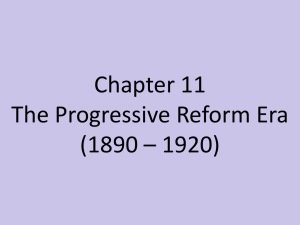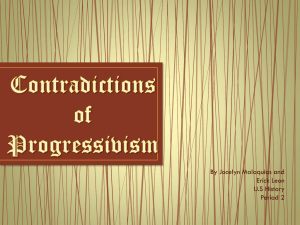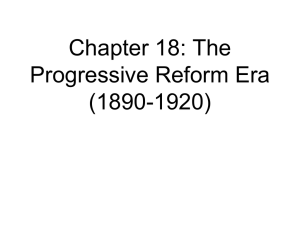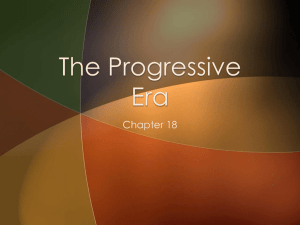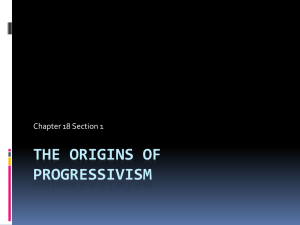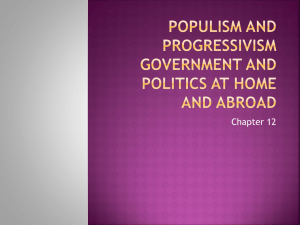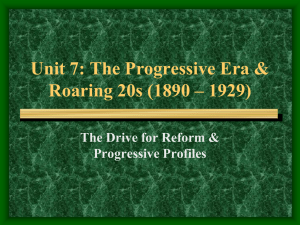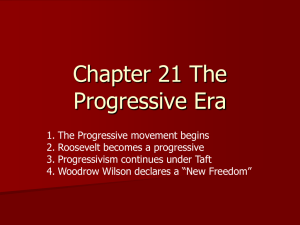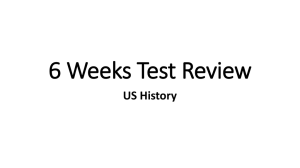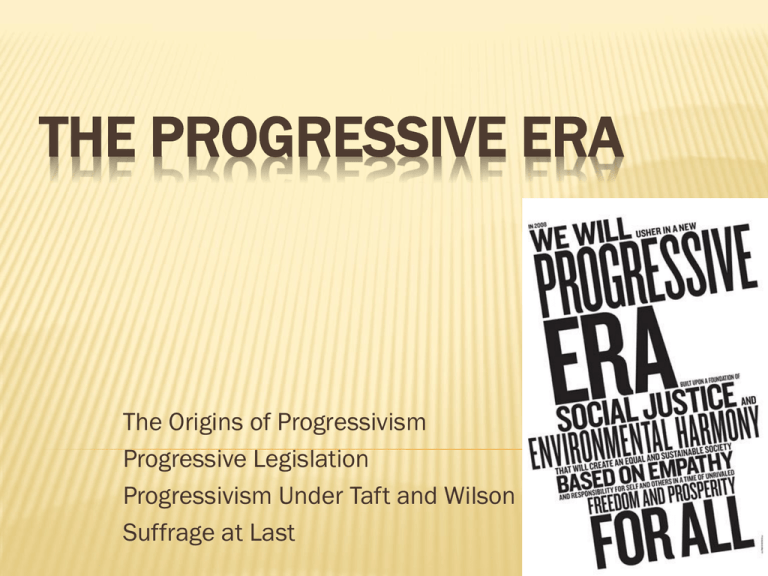
THE PROGRESSIVE ERA
The Origins of Progressivism
Progressive Legislation
Progressivism Under Taft and Wilson
Suffrage at Last
SECTION ONE:
THE ORIGINS OF PROGRESSIVISM
The Jungle by Upton Sinclair
Revelations about working conditions and poor food quality sent shockwaves
In the land of prosperity, the fact that live was horrendous for many didn’t seem to fit
The Progressive Era
Root of 20th Century Reform
Progressivism an extension of earlier groups that fought for reforms and changes
New Reformers were reacting to the changes brought about by the Industrial
Revolution and the massive increase in immigration
Despite poor conditions, immigrants and migrants continued to flood the cities
and conditions got even worse
New Reformers saw charity as important but not nearly enough help for those in
need
A political debate began about what could be done – THE PROGRESSIVE ERA
PROGRESSIVE GOALS/BELIEFS
The
Progressives: Their Goals and Beliefs (included
Republicans, Democrats and others)
4
Basic Goals
Government should be more accountable to its people
Government should curb the power and influence of wealthy
people
Government should be given expanded powers so that it could
become more active in improving the lives of its citizens
Governments should become more efficient and less corrupt s that
they could competently handle their expanded role
SECTION ONE:
THE ORIGINS OF PROGRESSIVISM
Igniting Reform: Writers and their Ideas – lively
debates about HOW to reform
Two Early Reformers
Henry George – wrote a book to explain why poverty continued to plague
even advanced societies
- he concluded poverty existed because some held onto wealth
(land) and did not use productively
- proposed government charge a tax on land (not just
improvements)
Edward
Bellamy – wrote
a book about futuristic US – a utopia - where
government had taken over businesses
- businesses reorganized to meet the needs of the people, not
make a profit
- Book was a HUGE best seller
MUCKRAKERS
The
MUCKRAKERS – writers who used their
literature to expose the worst of the US system. T.
Roosevelt condemned them saying “those who
earn their livelihood by telling scandalous
falsehoods about honest men.”
Upton Sinclair - The Jungle
Lincoln Steffens – The Shame of the Cities
Ida Tarbell – The History of Standard Oil Company
SECTION ONE:
THE ORIGINS OF PROGRESSIVISM
Progressive Reform Organizations (people inspired to get involved)
The Labor Movement – begun in the 1800’s, Unions really succeeded during Progressive Era
Socialists – Government control of property and income
NCL - National Consumers League – investigated conditions under which goods were produced and sold
Suffrage – Women’s Vote a key Progressive Era reform goal
Temperance – outlawing liquor also a Progressive Era reform
Two Women Reformers – pushed for reforms in workplace to protect women and children
Many wanted an end to the capitalist system, redistribute wealth, and government ownership of American Industries
Most wanted to reform the government thru the ballot box, but some willing to use revolution to create change
Women’s Groups – Though unable to vote, women played a HUGE role in Progressive Era
Business leaders used government courts to block strikes, but Unions continued to fight until they were able to force
reforms in the workplace and in government actions
Florence Kelley – Appointed by Federal government to investigate labor conditions. Resulted
in laws passed to prohibit child labor, limiting work hours for women
Mother Jones – along with her husband, Mother Jones became voice of the labor unions fight
for better conditions. Became a national speaker on behalf of unions and child labor laws
Progressive Reforms Meet With Resistance
The increased role of government in people’s lives concerned many, including those who the
reforms were intended to help
Didn’t want kids to work, but needed the income to survive
SECTION TWO:
PROGRESSIVE LEGISLATION
Triangle Shirtwaist Fire:
An Expanded Role for Government
Fire broke out in a shirt making factory. Only
exit not locked from outside were the stairs to the roof of the 10 story
building. In all 146 workers died. In the aftermath, a push for regulations
to prevent this from happening again led the way to other government reforms
After the Triangle Shirtwaist Fire, people expected the government to DO SOMETHING
Workers’ Rights, Working Conditions needed to be controlled
Progressives did not want government to control essential services (water, electricity)
SOCIAL WELFARE REFORMS: create a minimum standard of living
Unemployment benefits
Accident and health insurance
Social Security for Elderly and Disabled
Progressives wanted a government led by experts and run by professionals not politicians
SECTION TWO:
PROGRESSIVE LEGISLATION
Municipal Reforms (many wanted HOME RULE – limited self rule)
Attacking the Bosses
New Forms of Municipal Government
Commission form of government used to deal with the aftermath of the Galveston Hurricane
It worked so efficiently, that many other cities looked to this style of management
Council-Manager form of government used to deal with the Great Miami River Flood very
effectively
Cities Take Over Utilities
Civil Services (NO PATRONAGE)
While the push for reform changed some things, political machines will endure. They will just
figure how to work within the new structure of government
Reformers wanted to dislodge monopolies in water, electricity, gas (basic needs)
Toledo Ohio and Detroit Michigan pioneered city control or ownership of utilities
By 1915, nearly 2/3 ‘s of cities used some form of public ownership of utilities
Providing Welfare Services
Cities looked to provide public services like baths, parks, playground, kindergardens and lodging
for the homeless
It was believed by reformers that providing these services would make their cities better for
everyone
SECTION TWO:
PROGRESSIVE REFORMS
State Reforms (increased the role of government in business regulations and social welfare)
More Power to Voters:
* Direct Primary
* Initiative
* Recall
* Referendum
Reforms in the Workplace:
*
*
^
^
Curb workplace hazards
* Labor Departments to regulate business
Workers’ Accident Insurance
*
Business owners sued government saying they infringed on property rights, contract rights (COURTS AGREED)
Courts would only uphold if they could prove the reforms protected the public health
Wisconsin’s Reform Governor: Robert La Follette – 3 terms – used to reform his state
^ ousted party bosses
^ public votes on reform measures
^ Direct Primary & civil service reform
^ Brought in academics to reform government
SECTION TWO:
PROGRESSIVE REFORMS
Federal Reforms
TR’s Square Deal – Coal Strike – TR intervened and demanded both sides agree to arbitration.
Threatened to take control of mines with military. Workers got 10% raise and a cut to 10 hours per day work
“Square Deal” for both sides
Antitrust Activism – Used Sherman Antitrust Act to go after monopolies. Won 42 antitrust cases (Beef
trust, Standard Oil, American Tobacco Co. were either broken up or forced to reorganize)
Railroad Regulation – In 2nd term, TR aggressively pushed his reforms – took on railroads using both
executive and judicial powers to enforce laws (limit rates)
Protecting Public Health – Pure Food and Drug Act – required labeling of ingredients and strict
sanitary conditioning (because of the book “The Jungle”)
A New Labor Department – Department of Labor, Children’s Bureau, Women’s Bureau – created
to pass and enforce reforms in the workforce
Protecting the Environment – National Parks, US Forest Service – 200 million acres set aside.
National Reclamation Act passed – money set aside from federal land sales to pay for irrigation projects
New Constitutional Amendments –
16th Amendment – Congress could collect INCOME taxes – increased revenue to pay for relief programs
17th Amendment – Direct election of Senators – more accountability to the people
18th Amendment – Prohibition of Alcohol - saw alcohol as major cause of poverty and violence
POSTER WORK
In Groups of 3 – review p. 396-402
Identify 3 important points each for Taft & Wilson
Policies
Scandals
Accomplishments
Create a poster showing those points
Rubric
READABLE
NEATNESS
INFORMATION
2
2
5
10
SECTION THREE:
PROGRESSIVISM UNDER TAFT AND WILSON
Taft chosen by TR to continue on his programs. Easily won in 1908
Taft pledge to carry on reforms, but he wasn’t the politician TR was. Troubles
from the very start when Taft did not put any Progressives on his cabinet
CONFLICT OVER TARIFFS
Called a “special session” to pass reductions in tariffs
House barely passed his program, Senate instead raised tariffs. Taft signed compromise
which angered Progressives
THE BALLINGER-PINCHOT AFFAIR
Richard Ballinger chosen as Secretary of Interior – he sided with business over conservation
of federal lands. Businesses wanted to develop the lands
Gifford Pinchot, head of US Forest Service, favored scientific management of federal lands
Ballinger allowed a private interest to get rights to coal lands in Alaska. Pinchot charged
Ballinger with improper favoring of investment group. While Pinchot was testifying to the
corruption charge, Taft fired him. Pinchot was viewed as public hero. Ballinger eventually
resigned under accusation of corruption
SECTION THREE:
PROGRESSIVISM UNDER TAFT AND WILSON
Turmoil in Republican Party
Democrats and Republicans teamed up to attack non-reformists in the Republican Party who
had the power to block reforms. This bitterly split the Republican Party
Midterm Elections in 1910 – TR returned from vacation in Africa to find Republican Party in
turmoil. At first, he stayed quiet, but finally spoke up for reforms (business regulations, welfare laws,
workplace protection for women and children, income and inheritance tax, and voting reform ) NEW NATIONALISM
Republicans lost election (split vote) and Democrats gained control of House and Senate
Election of 1912
TR opposed Taft for Republican nomination. TR popular with voters, but Taft control party. TR
charged fraud and vowed to create his own party “THE BULL MOOSE PARTY”
The Bull Moose Party – a reformist party, very popular with women
TR shot while campaigning, continued his speech for 1/5 hours before going for medical attention
Taft’s Record – Taft accomplished a lot when president (set aside millions of acres of federal
lands, Children’s Bureau, 16th & 17th Amendments)
Wilson’s NEW FREEDOM – Democratic Party led by Woodrow Wilson, a reformist. He
promised to go after monopolies and trusts
A Four-Way Election – Taft, TR, Wilson and Eugene V. Debs (Labor leader, Socialist)
Split Republican vote handed Wilson the Presidency
SECTION THREE:
PROGRESSIVES UNDER TAFT AND WILSON
WILSON’S Policies as President
Tariffs and Taxes
Attacking the Trusts
To overhaul banking system, the Federal Reserve created. The “FED” is a national banking system
that regulated banks by putting them under the control of 12 regional banks. Created rules for
banks to hopefully make them stronger and more “user friendly”
Brandeis to the Supreme Court
Study showed a small group of men controlled most of the nation’s wealth, despite Sherman
Antitrust Act
1914 – Clayton Antitrust Act strengthened government power to go after monopolies and trusts,
protected unions
Federal Trade Commission (FTC) created to control business practices
Federal Reserve
1st action to reduce tariffs from 40% to 25%
To make up for lost revenue, federal income tax created
Louis Brandeis, a progressive lawyer, appointed to Supreme Court
His appointment was the height of the “Progressive Movement”
Wilson wins 2nd Term
Progressive Drive and Anti-war promise won Wilson a 2nd term, barely
SECTION THREE:
PROGRESSIVES UNDER TAFT AND WILSON
The Limits of Progressivism
By the mid 1910’s, broad changes in society, government, and business
had occured
Social Justice and Progressivism
Little done to aid tenant and migrant farmer
Many Progressives favored immigration limits and literacy tests
Jim Crow laws allowed to stand
African Americans were, basically, ignored by Progressive Movement
The End of Progressivism
As World War I spread in Europe, Americans became more worried about war than
reform
By 1916, the “Progressive Movement” lost momentum and faded away
The one push for reform that survived and grew strong was for WOMENS SUFFRAGE
NEED TO KNOWS
VOCABULARY
Bull Moose Party
Civil Disobedience
Conservationist
Federal Reserve System
Holding Company
Injunction
Muckraker
Municipal
New Nationalism
Progressive Era
ESSAYS – ANSWER BOTH
1)
How was President Wilson’s approach to economic reform similar to that of
Theodore Roosevelt? How were they different?
2)
What two main strategies did women’s suffrage activists use in the late 1800’s and
early 1900’s? How did each strategy contribute to the passage of the 19th
Amendment?
CREATE A ORGANIZATIONAL CHART
P. 403-407
Find 3 – 5 facts about what
EACH women did to
advance the cause of
womens’ suffrage
Alice
Paul
Susan B.
Anthony
Womens
Suffrage
Movement
Carrie
Chapman
Catt
Elizabeth
Cady
Stanton
SECTION FOUR
SUFFRAGE AT LAST
For over 70 years, women’s organizations fought for the right to vote
With every push forward, there were just as many pushes back
Women weren’t capable of voting, women didn’t want to vote, women voting would damage society
Anthony and Stanton: Preparing the Way
Seneca Falls Convention-1st national meeting demanding women’s vote (1848)
Later, group split into 2 factions
Lucretia Mott, Elizabeth Cady Stanton & Susan B. Anthony
“Men, their rights and nothing more. Women, their rights and nothing less”
National Womens Suffrage Association – focused on an amendment to ensure/protect women’s right to vote
American Woman Suffrage Association – state by state approach to womens vote
CIVIL DISOBEDIENCE – a nonviolent refusal to obey a law in an effort to change it
Susan B. Anthony led her group (NWSA) and was arrested. Found guilty, she refused to pay. Judge let her go
SUFFRAGIST STRATEGIES
Constitutional Amendment
2/3 BOTH houses of Congress, ¾ of state legislatures vote to approve
1868 – 1st attempt failed
1878 – 2nd attempt got hearing
“The right of a citizen of the United States to vote shall not be denied or abridged by the United States or by any
state in the account of sex”
1887 – defeating in Senate by a vote of 16 for and 34 against (26 absent)
Called up every year until 1896. Then not again until 1913
State by State
More successful to begin with, especially out west
Women had proven their worth working hard to survive the tough times
SUFFRAGE AT THE TURN OF THE CENTURY
National American Woman Suffrage Association (NAWSA)
A New Generation
Susan B. Anthony and Lucy Stone
Many rights won for women (property rights most important)
Social Groups formed to fight for their right to vote
Began lobbying officials, marching, picketing, etc
The rise of the Progressive Movement put new life into the fight for the right to vote
Anthony died in 1902 and Stone died in 1906 without seeing their goal achieved
Carrie Chapman Catt took lead of NAWSA
Alice Paul also rose to lead the movement
These women would lead a march of over 5,000 in Washington DC in 1913
Split in the Movement
Paul (Congressional Union) called for aggressive, militant campaign for amendment
NAWSA believed this would alienate followers, refused to back Paul, expelled from NAWSA
Paul and CU demonstrated in front of White House and burned an effigy of Wilson. Paul
and followers were arrested and jailed. They went on hunger strikes
NEW PLAN
NAWSA continued to back state suffrage campaigns.
Pushed in 4 key eastern states, failed
Catt reinstated at leader of NAWSA and came out with her “WINNING PLAN”
World War I
Get Congress to re-introduce a federal amendment for womens suffrage
NAWSA, now with over 2 million in membership, won in NY state. This effected the electoral
and congressional votes at the national level
Women will pitch in and help in the war effort so well, they gain much respect
The idea that women should stay out of the “man’s world” ended with the war effort
18th Amendment – Prohibition – adopted, with much support of women
Finally, Victory
1919 – Congress formally proposed the Suffrage Amendment
Political pressures were finally on the side of women voting
Lasting embarrassment over the treatment of Paul and CU when jailed
1920 – Tennessee becomes state that pushed over the top
19th Amendment guarantees women the right to vote – last major reform of Progressive Era
NEED TO KNOWS – CH 11
VOCABULARY
Bull Moose Party
Civil Disobedience
Conservationist
Federal Reserve System
Holding Company
Injunction
Muckraker
Municipal
New Nationalism
Progressive Era
ESSAYS – ANSWER BOTH
1)
How was President Wilson’s approach to economic reform similar to that of
Theodore Roosevelt? How were they different?
2)
What two main strategies did women’s suffrage activists use in the late
1800’s and early 1900’s? How did each strategy contribute to the passage
of the 19th Amendment?

